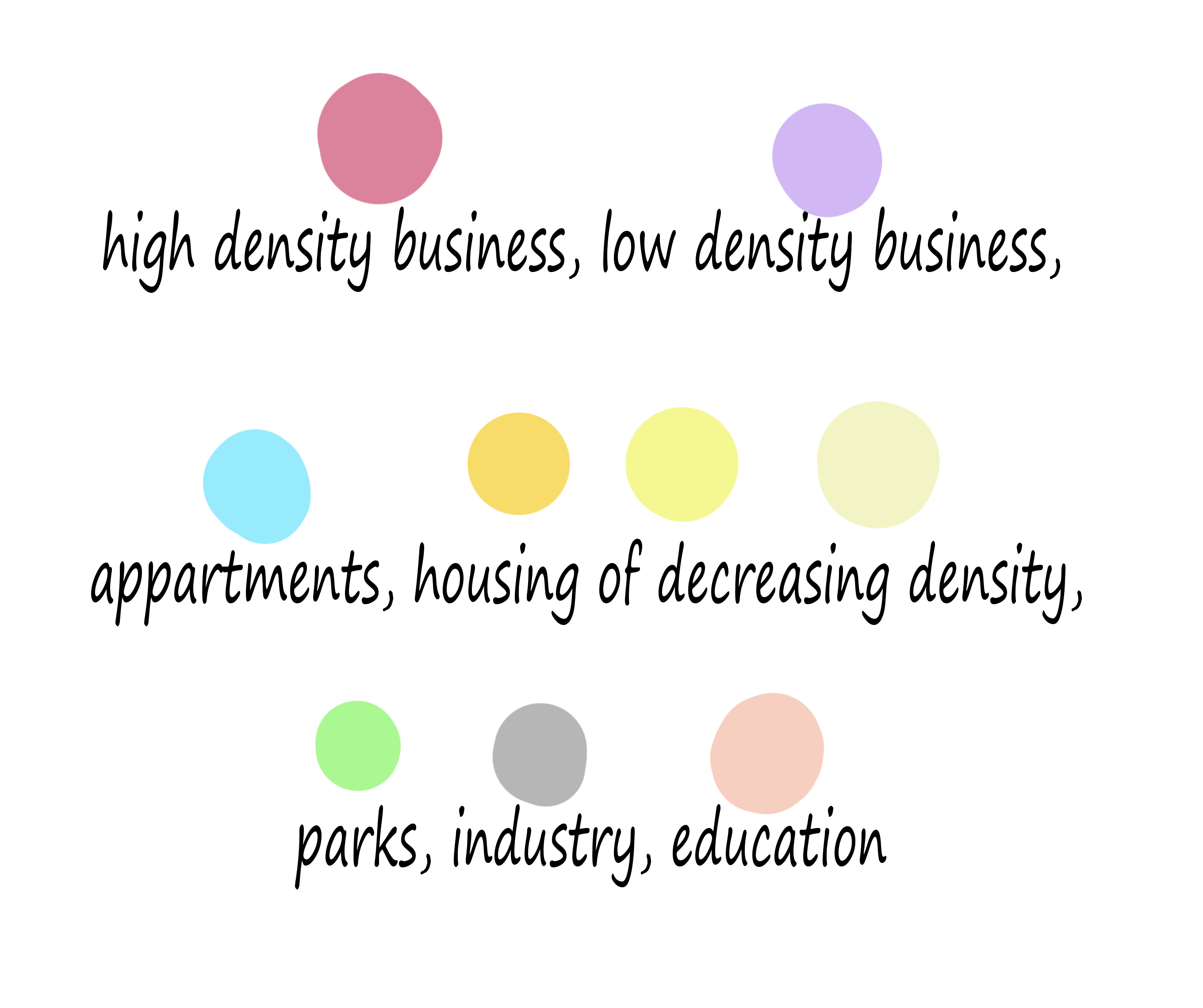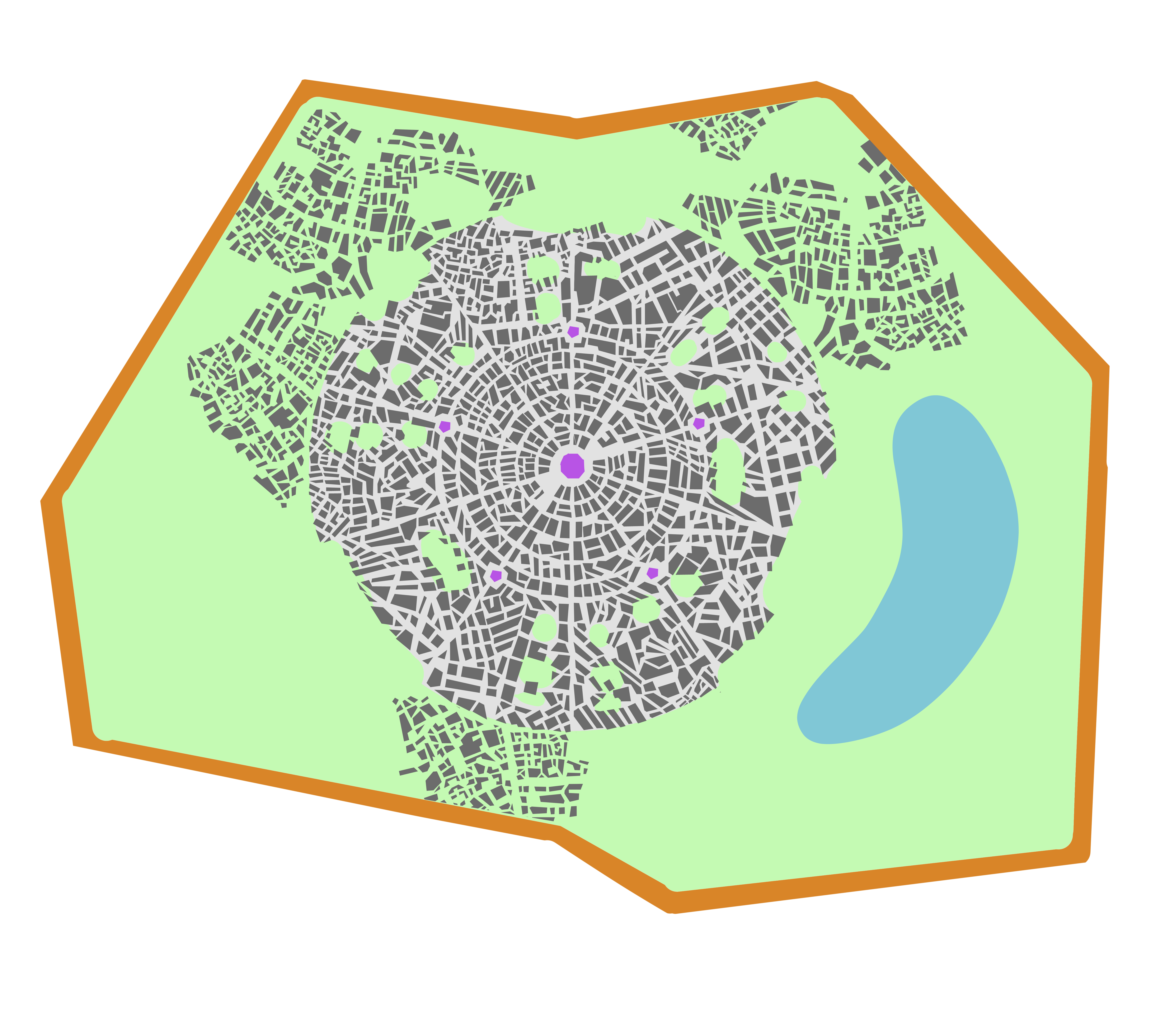
The first city is nestled deep within a thick forest, near a coast with steep cliffs. From atop the city walls one can see out over the long ocean or deep into the woods. As a typical tier 1 world, mana flow is abundant and morphogenic consistency is low. Magical creatures thrive and highly technological creatures find themselves changed in significant ways as their bodies adapt to the norms of the setting. The weather here is temperate, with 4 distinct seasons but fairly mild winters and summers.
The main city of Spire itself is tucked away here within the trolls' capital city, with several miles between the edge of Spire and the city walls. Though non-trolls are forbidden passage through the walls, the trolls have allowed for some settlement within those miles.
A large lake to the southeast is rimmed by manicured parks and wide fields. The streets of the first city are spacious, allowing for both easy travel by troll caravans as well as creating ample space for bustling street markets.
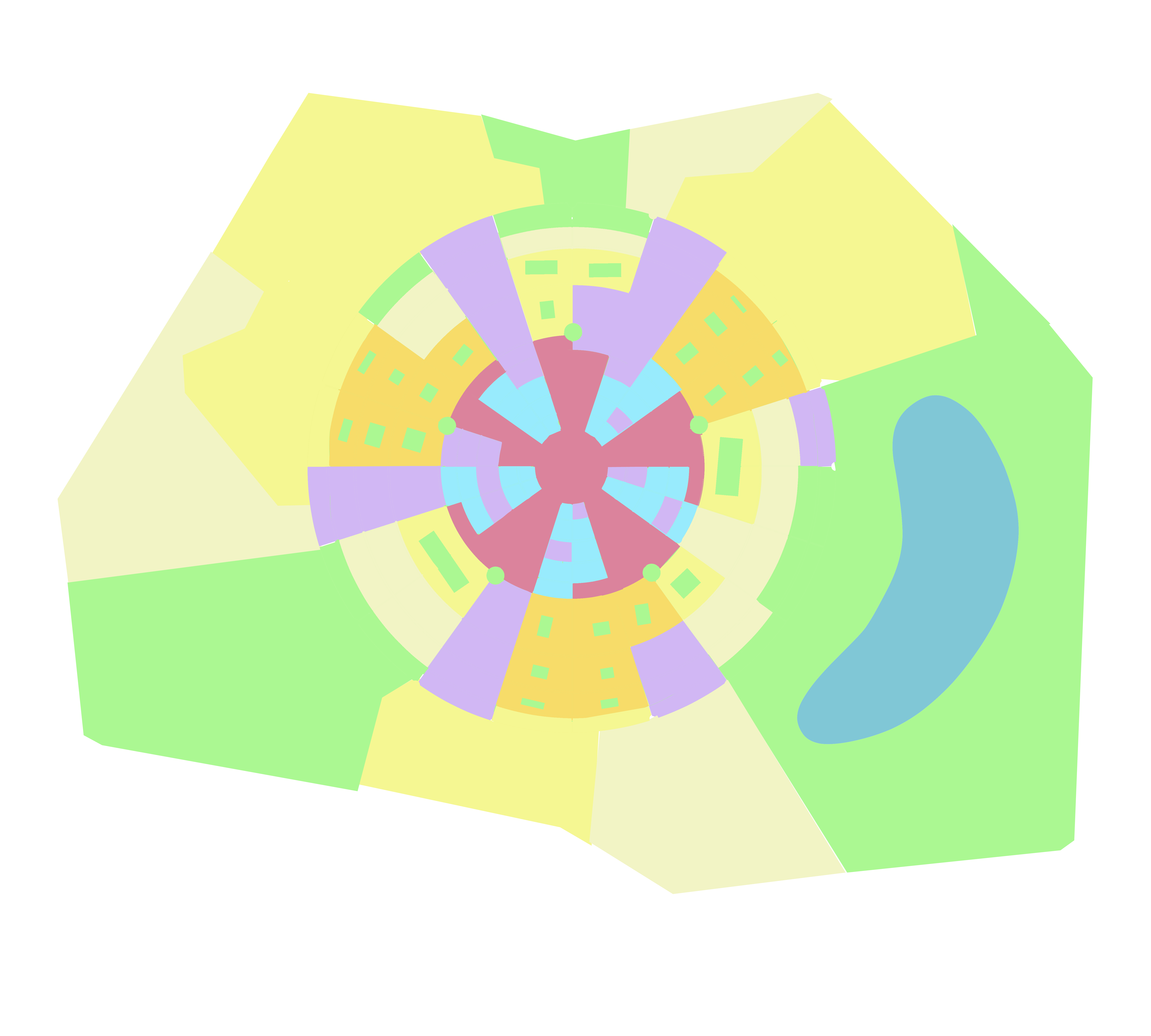
The center of the first city, surrounding the spire, is a bussling maze of markets and dense housing. It's a coveted spot for Spire's most influential business leaders, who build their livelyhoods on the constant flow of goods through these central streets. Strict building limitations in the first city mean that there are no sky scrapers; only the spire itself is tall enough to be seen from beyond the far walls. Most buildings within the inner ring of the city press right up against this height limit.
As you travel away from the city center, buildings become shorter and more spacious, the streets more mild. There is always a shop or market to be found in the first city, always someone who's open and eager to solve your problems for a little coin. Or for stranger trades, here among the trolls. Gardens and parks are common in the outer city, past the portal ring, as they are in most of Spire's cities.
Beyond the circular perimiter of Spire proper, the troll capital becomes a much slower paced affair. Housing at this distance is expensive but spacious, and a good option for any non-citizens hoping to make their homes near the city. Wide spaces are kept as rolling garden and are tended to produce moderate amounts of food year round. Other fields serve as the staging ground for troll caravans leaving and entering the city.
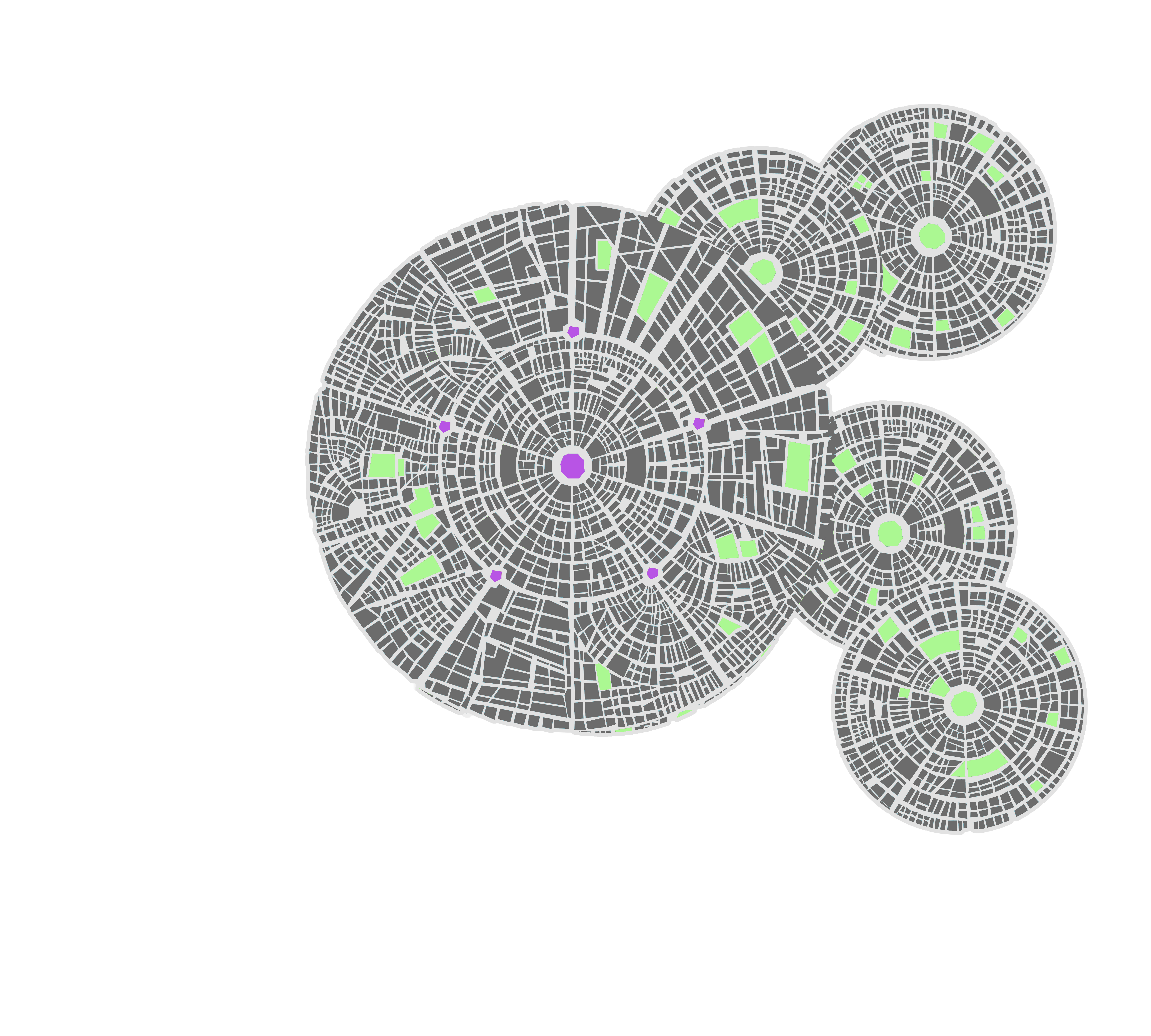
The second city is nestled in the storm-shadow of a mountain range, protecting it for half the year from the sand storms that blow continually from one pole to the other. It is a Tier 2 world, with steady mana flow and low morphogenic consistency. Magical creatures do fine here, and technological constructs only find themselves changed with prolonged intense temperature fluctuations.
The second city is built within a massive glass dome, built and maintained by orcs and other studied engineers. The historic city forms a perfect circle, though deals with the orcish king over the last century have granted Spire some additional lands to the East and the manpower to build smaller protective domes over them.
A great mountain range curls around Spire to the South and West, with many orcish cities and towns nessled in its peaks. Spire itself is shaded by the mountain, protected for half the year from the desert winds, but faces brutal sandstorms from the north during the other half.
The second city is warm and humid, the light refracting into a million glistening rainbows as it passes overhead.
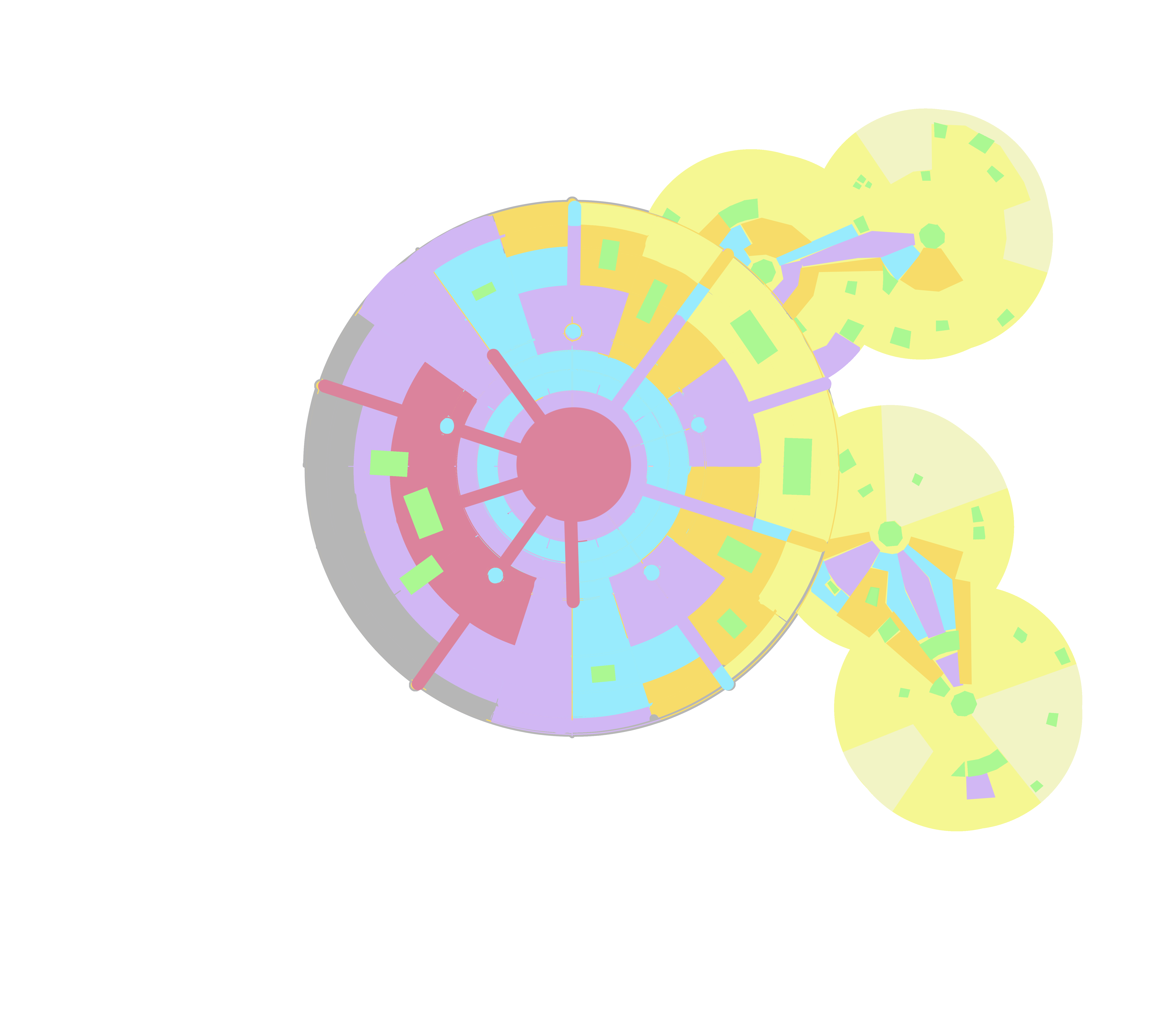
The center of the second city, like most of Spire, is dense with businesses. Unlike the first, though, the second city is decidedly asymetrical. To the Southwest, industry thrives. Towering buildings of sandstone and glass and marble cluster around the transit portals, buzzing with activity. Sprawling shopping districts gradually fade into business parks and warehouses. Nearer the great dome, taking advantage of the easier ventilation on the periphery, industry thrives.
Here, a million factories josstle for space, hoping to take advantage of the narrow band where one can take tap into both the fresh air outside the dome and the stream of high tech goosd that flows through the portals.
Across the city, spreading past the main spire and into the northeast, glistening appartment complexes and condos gradually give way to cozy neighborhoods. The many scattered parks host sturdy desert plants and thriving succulent gardens. In the newer additions, sprawling manors for Spire's richest elites host cool springs and stunning views of the gas giant that dominates the second world's sky.

The third world is the only plane of Spire which contains other connections to other worlds. It is a nexus world, a sieve of a world, connected here and there and everywhere to other worlds. It is a neutral world, both in terms of mana flow and morphogenic consistency, the prototypical tier 3. This means that both magical and technological entities can traverse the world unchanged without any innate negative effects from the universe itself. There is a low level of ambient mana, not enough to power most spells but enough to maintain any spells already cast and to protect the biological functions of highly magical creatures. Similarly, morphogenic consistency is high, so technological entities and devices can cross the plane unchanged in either their form or basic functions.
The third city is divided into four clean quadrants, each belonging to a different seasonal court of the fae wilds. Spring to the Southeast, Summer to the Southwest, Fall to the Northwest, and Winter to the Northeast. The roads between the four courts are wide and well traveled, extending far beyond the edges of Spire, and are often considered the safest path to travel for explorers leaving the city.
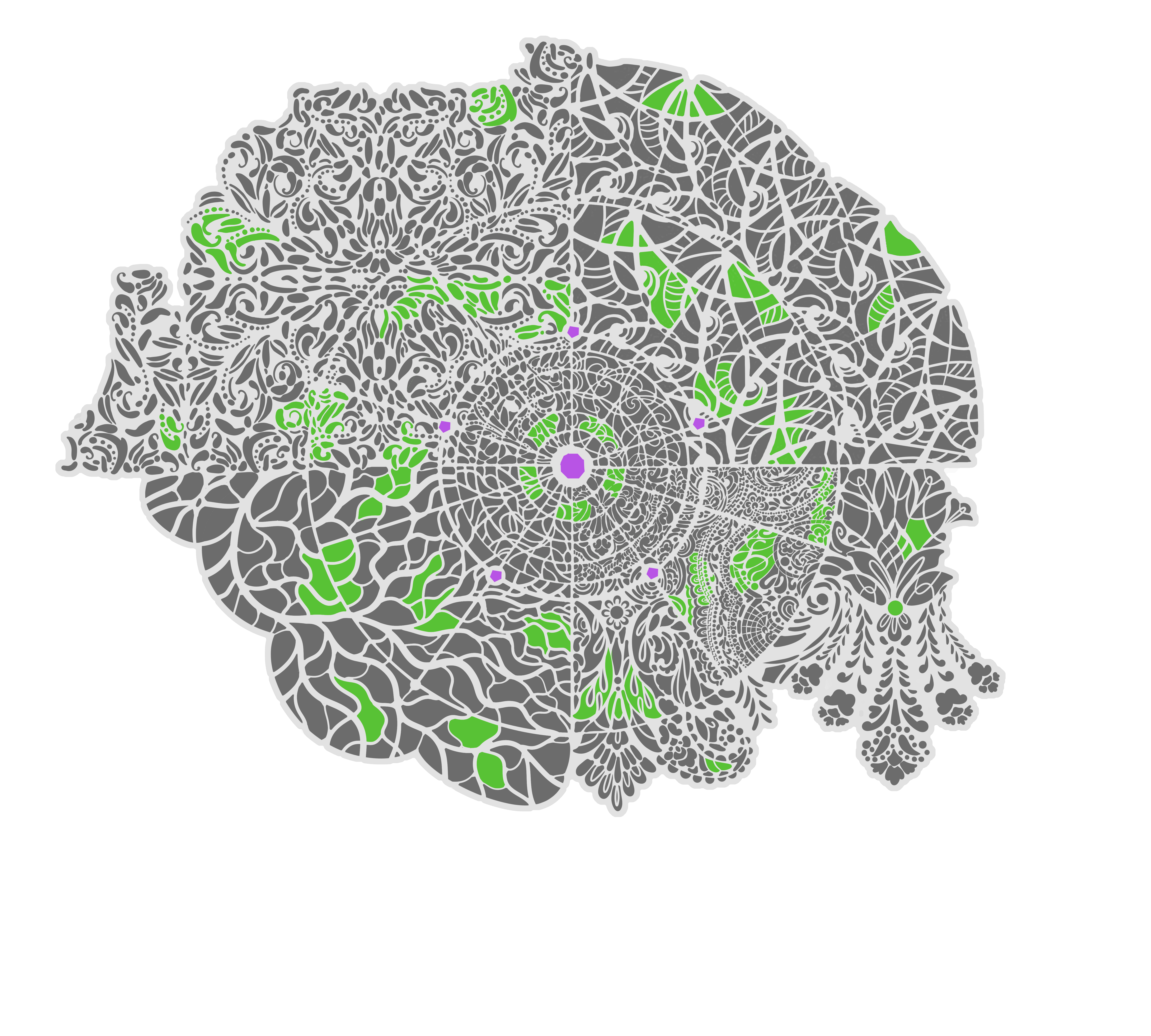
The streets of the third city are chaotic. Shaped by centuries of accumulating shallows, they mimic the fractal patterns of the courts that formed them. Spiraling alleys lead to quiet secluded corners or, just as often, dump you unexpectedly into the rushing chaos of a main thoroughfare.
Each quadrant of the third city boasts unique architectural styles, fitted to both the aesthetics of their courts and the material needs of their season. Though the overall seasons within the third city shift each year, as the fae delegate to Spire passes the crown on to the next court, the reigning season rarely fully overtakes the others within the city. The Winter court is always chill, even at the height of Summer's rule.
The massive infrastructural undertakings that saw the portal ring constructed, also saw large swaths of the Wilds ceded to Spire. Countless smaller deals over the years have seen different courts give up portions of land for various advantages. The outer boundary of the third city, then, is wavering and inconsistent, a far cry from the perfect circles of the fourth and fifth.
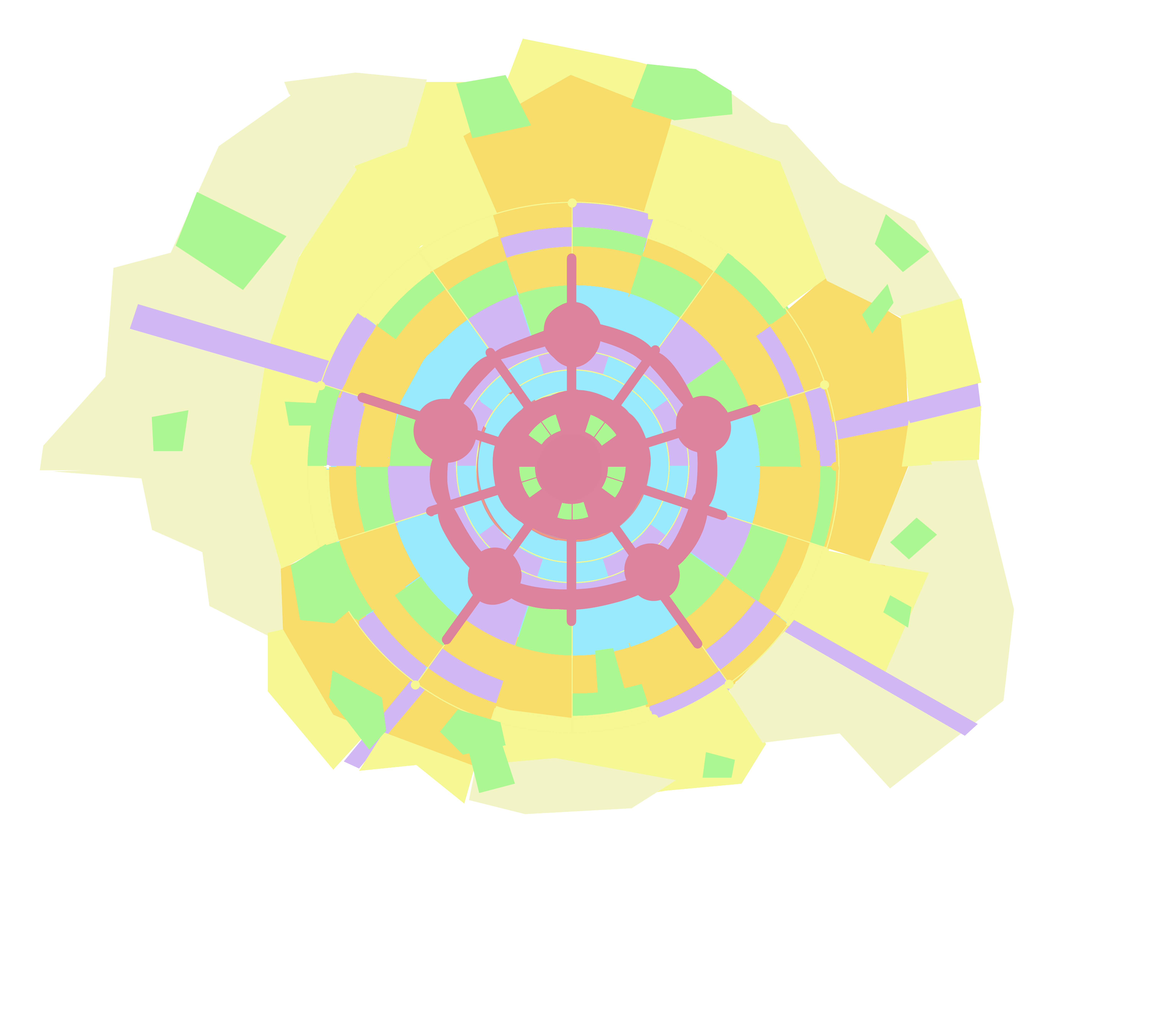
Despite these seasonal tensions, or perhaps because of them, the third city is largely symetrical in the uses of its space. Brilliant gardens cluster between the offices complexes around the spire, displaying the luxury and splendor that the courts can boast. Smaller business districts cluster around the portal ring.
Most of the third city is dedicated to residential districts. More than any other city of Spire, the third city is for living in. Libraries, museums, tea houses, restraunts, grocers, all the necesities of living can be found in any of its neighborhoods. Long tree-lined avenues turn into cozy town squares. Parks host benches and soft grass. Narrow and convoluted streets encourage pedestrian traffic. Even among the main roads, where larger shops congregate, the third city prioritizes comfort and beauty.
The third city also hosts Spire's largest subhurbs, as these sprawling neighborhoods extend far past even the expanded city limits.
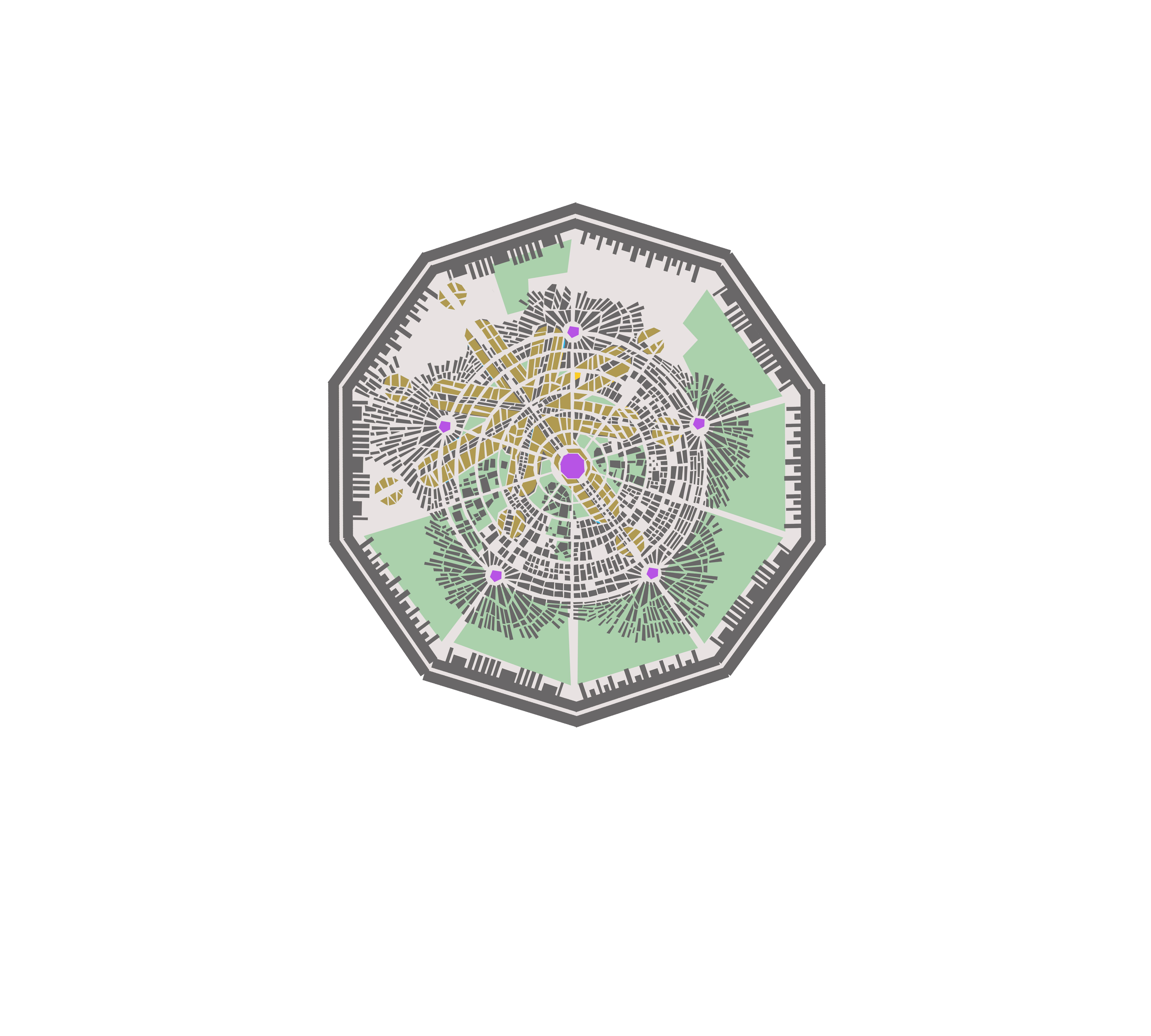
The fourth world is a tier 4 world. Technological entities and devices function as designed regardless of realm of origin, while magical entities and constructs will experience mana deprivation and its associated effects if extended time is spent far from the portal loops. Though Spire's scientific community is highly confident in this classification, it's effectively impossible to get far enough away from the portal networks to test this theory thoroughly.
The fourth city is surrounded by a tall wall at roughly the same distance from the Spire as the outer boundaries of the second and fifth cities. Outside the city wall is a ring approximately two miles thick, a flat plane with sparse grasses. Beyond that is the outer wall, which was built and maintained by the human population of the fourth world. Passage across this plane is strictly disallowed by governments of both Spire and the humans beyond.
The streets of the fourth city are a startling clash of styles. Modern architecture, including many stunning glassworks by orcish engineers, stands side by side with expansive ancient ruins. The large six-sided starburst around which the fourth city formed is still largely intact, though many discreete portions have collapsed over the years.
The street layouts of the fourth city reflect the tensions of this world. Loosely arrayed campuses near the ruins' heart reflect the academic origins of the city. The wide fields rimming the walls speak as much to the population's warriness of what lies beyond as they do to the population's food needs. Sandwiched in between, radiating out from the portal network, lie neighborhoods of denser building.

The fourth city is home to the vast majority of Spire's higher education opportunities. College campuses sit on sprawling lawns, surrounded by tightly packed high density housing. The ruins at the heart of the fourth city are slowly being converted into further academic centers, as they're rung dry of their secrets. The spire itself, while fully functional, is penned in by the ruins. What business districts exist are clustered around the portal rings where transit is faster and easier.
Beyond this small business district is some of the cheapest and lowest density housing available in Spire, gradually fading into the city's ring of interior farmland. Beyond that is the wall itself, a thick military instalation which bulges inwards to meet the city streets on the northwest side.

The fifth world is a high-technology world, tier 5. Global communication networks, sophisticated weaving and metalworking, caverns and tunnels lined with polished ores and adaptive woven pathways. There is no natural mana flow, and magical entities will find themselves in great peril if they leave the confines of Spire. Enchantments degrade rapidly and new spells are impossible. Technological entities are reliable and healthy.
The fifth city itself is situated in a large subterranean cavern, surrounded by miles of rock and carved tunnels. The portal ring lies along the outer edge of this cavern. The earth is rich in iron and other mineral resources, and only the area immediately surrounding Spire has been stripped fully of iron traces. For this reason it's strongly advised that any entities from worlds of tier 3 or lower stay within the city and do not venture further into the Dwarven tunnels.
The streets beyond the portal ring are carved into the earth, giving an effect which some find cozy and comforting, and others find horribly claustrophobic. The street layout of the fifth city was carefully designed and is perfectly symmetrical, radiating evenly out from the spire. It's optimized for quick travel across the city, especially to and from the portal ring.

The centermost ring of the fifth city holds a busy business district, but even here the streets are calmer than they are in most of Spire. Electric lights line the streets on thin strings, and a constant cool breeze blows from advanced dwarven ventelation ducts. Five educational campuses sit near the center, primarily serving as trade training. Most of the city is dedicated to high density housing and tight-knit neighborhoods. Each housing pod consists of between three and ten households, arrayed around a house-sized shared garden. These gardens are optimized for oxygen production, CO2 scrubbing, low light tolerance, and durability. While the fifth city hosts only five parks large enough to show on this map, greenery is an abundant part of daily life for those who live here.
Like the third city, small businesses and community centers are common throughout the residential districts of the fifth city. Unlike the third, the fifth city also hosts a bussling nighlife. In some cases the nighlife runs 24/7, thriving in the endless dark.
Beyond the residential and entertainment districts, industry takes over. Power plants, fabrication centers, and any odd manufacturing job that any of Spire's dwarves are interested in pop up across the outer edge of the city. The boundary is carefully measured to protect workers from mana deprivation, the ventelation redirected outwards from the city center to keep the inner air clean and sweet. The tunnels beyond are easily accessable, but dangerous for any magical entity, and it's unlikely you'll get far before attracting a Diplomat escort.
